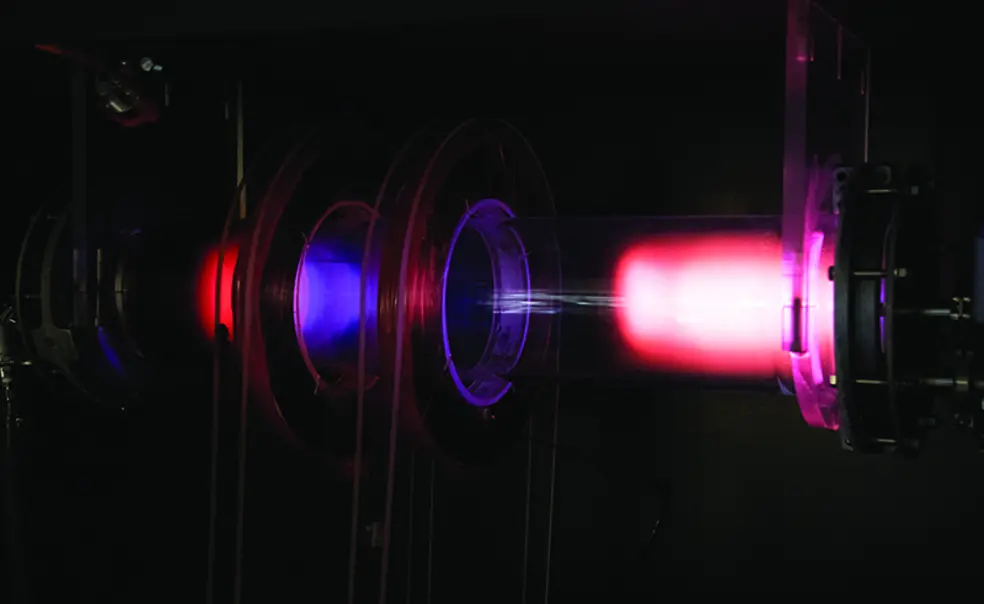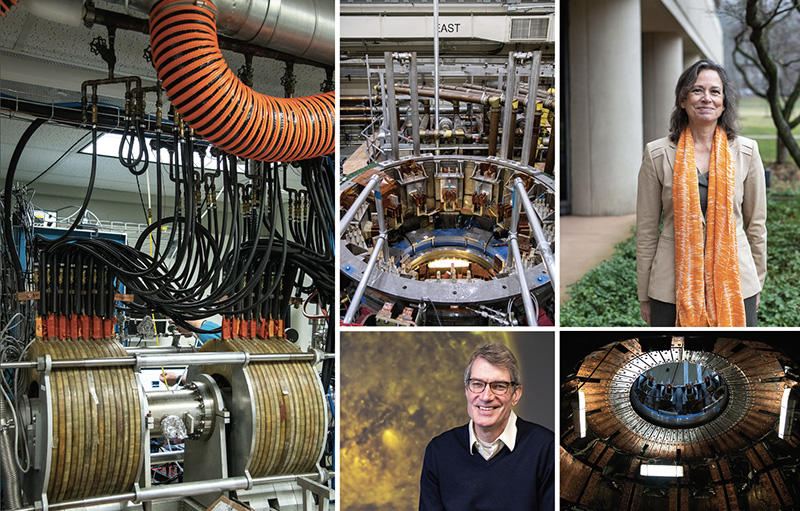Princeton Plasma Physics Lab Takes on Sustainability Science
The PPPL has catalyzed its own change and decided to venture beyond fusion
In a small, dark, and unassuming physics lab, silent except for the hum of gadgetry, research physicist Yevgeny Raitses points at a metal box the size of a microwave with tubes snaking in and out of it. Raitses, who works at the Princeton Plasma Physics Laboratory (PPPL), explains what can happen to the methane inside the box. With the help of electrically charged gas called plasma, methane, a more potent climate-warmer than carbon dioxide, transforms into two desirable products — solid carbon and hydrogen gas, he says. This transformation is just one way scientists at PPPL plan to use their crown jewel, expertise in plasma, to combat the warming of the Earth.
One of 17 U. S. Department of Energy national labs, PPPL sits off Route 1 a few miles from Princeton’s main campus, on Stellarator Road — named for a device that uses magnetic fields to hold super hot plasma for fusion experiments. Since the lab’s inception in 1961 — 10 years after fusion research began at the site — it has focused solely on that climate-saving silver bullet: producing energy via fusion, a process with no emissions or major safety concerns.
Recently, however, with a climate crisis looming ever larger and the Biden administration committing to fighting climate change, PPPL catalyzed its own change and decided to venture beyond fusion. “The Biden administration has put its money where its mouth is on investing in new technologies to make America and the world more sustainable, and a certain fraction of them are plasma technologies,” says Steve Cowley *85, the director of PPPL and a professor of astrophysical sciences at Princeton. Through the Inflation Reduction Act, PPPL received $25 million to put toward lab infrastructure improvements and the Princeton Plasma Innovation Center, a state-of-the-art office and laboratory building that will support different kinds of plasma-related research. Over the past four years, PPPL’s staff has expanded from about 500 to 700 employees, and more growth is projected. When it was time to find a leader of PPPL’s extended mission, Cowley thought of someone 3,000 miles away who had a long history at Princeton.
Emily Carter, then the executive vice chancellor and provost and distinguished professor at UCLA, had been a professor in Princeton’s Department of Mechanical and Aerospace Engineering and its Program in Applied and Computational Mathematics from 2004 to 2019, and during that time also served as the Gerhard R. Andlinger Professor in Energy and the Environment and the dean of the University’s engineering school. It was at Princeton where Carter pivoted her own research toward climate mitigation efforts after reading the Intergovernmental Panel on Climate Change’s 2007 report, which underscored the impact humans were having on the climate. She became the founding director of the University’s Andlinger Center for Energy and Environment. When asked if she would lead the sustainability effort at PPPL, Carter said yes, realizing, “we had a short time window because of climate change and the political climate, and we had to take advantage of Biden’s visionary moment in an urgent way.” In 2022, Carter returned to Princeton, this time as the senior strategic adviser and associate laboratory director for applied materials and sustainability science at PPPL and the Gerhard R. Andlinger Professor in Energy and the Environment at the University.
While the plasma used for fusion is hot, reaching more than 200 million degrees Celsius, lower temperature plasmas (some even at room temperature) hold promise for applications that can reduce greenhouse gas emissions or even battle climate change directly. “The lab is at the forefront of probing the behavior of plasmas,” says Carter, “and we wanted to leverage that strength.”
When it comes to emissions, many think of vehicles such as cars and airplanes, but the problem is more insidious, says Carter. “The manufacturing sector uses fossil fuels for everything — chemicals, fuels, materials — and that leads to carbon dioxide emissions.” Carter is leading teams of scientists to develop different processes, called electromanufacturing, whereby rather than fossil-fuel burning, clean electricity and plasma supply the energy needed to transform substances in manufacturing, emissions-free. Cowley explains, “With plasmas, you can target exactly the chemical pathways that you want to go through in order to make something; you take fossil fuels out of the manufacturing process, and replace it with much more surgically and scientifically derived processes that can use electricity.”
Carter organized a retreat last spring with PPPL staff and scientists from Princeton and Columbia, and the University of Maryland to develop electromanufacturing research proposals. Now, two of Carter’s teams are finalists in a Clean Energy Manufacturing Innovation Institute competition meant to help industries move off fossil fuels. “Our part is to lead the effort in terms of plasma-assisted processes,” says Carter.
Another of Carter’s initiatives attacks climate change directly. There’s a possibility, Carter says, that we may need to find ways to reflect the sun’s rays away from the Earth and vent the Earth’s warmth into space. “I hope we don’t have to do it,” Carter says, “but it’s a matter of national and global security. We need to understand the science involved, and if a rogue state were to try and do it, we need to understand the consequences.” Carter held another retreat for Princeton climate scientists on this topic, and is putting together an international collaboration focused on the physics and chemistry of how particles suspended in the air, known as aerosols, interact with clouds, light, and each other. “We can extend PPPL’s strengths in understanding plasmas to aerosols and further refine climate intervention models,” says Carter. “We need to keep this in our back pocket if we hit a climate tipping point.”
Carter describes the plasma-assisted breakdown of methane as a “beautiful chemical reaction,” in contrast to the standard method of treating methane with steam, which simply exchanges one greenhouse gas for another, producing carbon dioxide and hydrogen in place of methane. Getting the plasma-catalyzed reaction just right yields carbon in a highly sought form: structures a thousand times thinner than a human hair, called carbon nanotubes. Carbon nanotubes are strong, with high thermal conductivity, and could one day replace concrete and asphalt. The hydrogen could be used for multiple purposes in industry or as a clean fuel. “We could gather methane, and then one could envision having a small, portable plasma discharge device to turn it into carbon and hydrogen,” says Carter.
While the urgency of climate change has seeped into more of the public consciousness only recently, Cowley says it has concerned scientists for decades. Many of today’s climate solutions are the result of years of research, and we have further to go. “Part of our job is to find exceptional young people and train them with the skills needed to innovate,” he says.
“This requires lots of research and development,” echoes Carter. “Ultimately, we will have to transform all parts of our society off of fossil fuels, and other carbon dioxide and greenhouse gas-emitting processes. The scientists we are bringing together are absolutely committed and enthusiastic about working on solutions to a whole variety of problems in the sustainability space.”













No responses yet